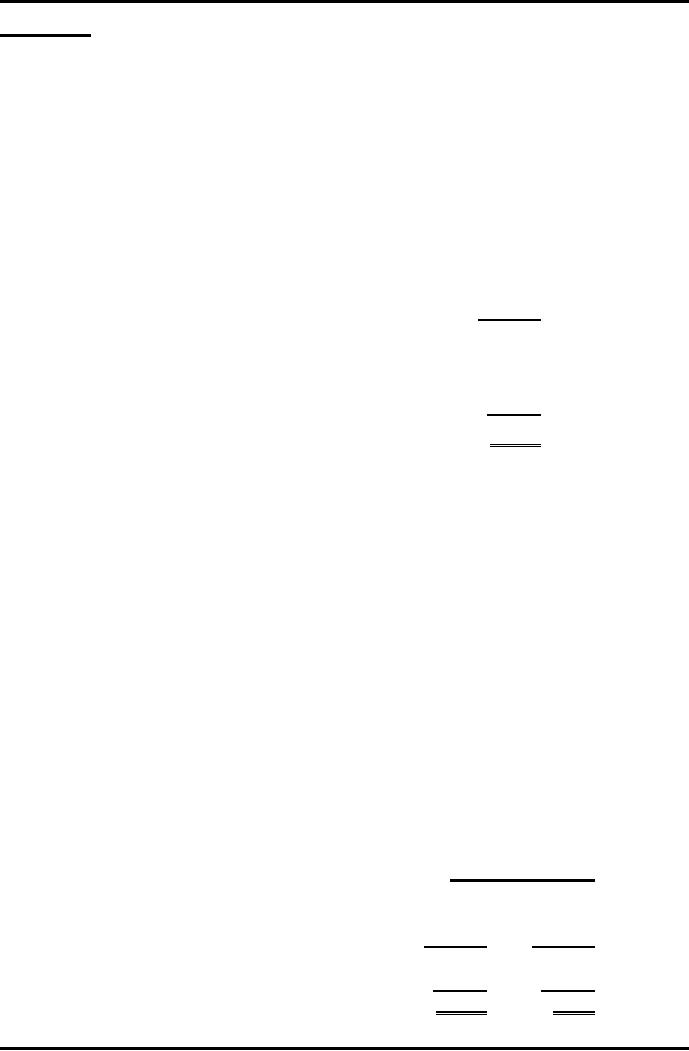 |
ACCOUNTING POLICIES, CHANGES IN ACCOUNTING ESTIMATES AND ERRORS 2 |
| << ACCOUNTING POLICIES, CHANGES IN ACCOUNTING ESTIMATES AND ERRORS 1 |
| BORROWING COST >> |

Advance
Financial Accounting
(FIN-611)
VU
LESSON
# 30
IAS
8
ACCOUNTING
POLICIES, CHANGES IN ACCOUNTING ESTIMATES
AND
ERRORS
CHANGES IN
ACCOUNTING ESTIMATES:
As a
result of the uncertainties
inherent in business activities, many
items in financial
statements
cannot be measured with accuracy but
can only be estimated.
Estimation
involves
judgments based on the
latest available and reliable
information. For
example,
estimates may be required
for:
a)
Doubtful
debts,
b)
Inventory
obsolescence;
c)
The
fair value of financial assets or
financial liabilities;
d)
The
useful lives of, and
expected pattern of consumption of
the future economic
benefits
embodied in depreciable asset,
and
e)
Warranty obligations.
The
effect of a change in an accounting
estimate, other than a change to
which
following
paragraph applies, shall be
recognized prospectively by including it
in
profit
or loss in:
a)
The period of the change, if
the change affects that
period only; or
b)
The period of the change and
future period, if the change
affects both.
To
the extent that a change in
an accounting estimate gives
rise to changes in assets
and
liabilities, or relates to an item of
equity it shall be recognized by
adjusting the
carrying
amount of the related asset,
liability or equity item in
the period of the
change.
a)
Prospective recognition of the
effect of a change in an accounting
estimate
means
that the change is applied
to transactions, other events and
conditions
from
the date of the change in
estimate.
b) A
change in an accounting estimate may
affect only the current
period's profit
or
loss, or the profit or loss
of both the current period
and future periods.
For
example, a change in the
estimate of the amount of bad
debts affects only
the
current
period's profit or loss and
therefore is recognized in the
current period only.
However,
a change in the estimated
useful life of, or the
expected pattern of future
economic
benefits embodied in a depreciable
asset affects depreciation
expense for the
current
period and future periods during the
asset's remaining useful
life. In both
cases,
the effect of the change
relating to the current
period is recognized as income
or
expense
in the current period. The
effect, if any, on future periods
is, recognized as
income
or expense in those future
periods.
160

Advance
Financial Accounting
(FIN-611)
VU
Example-8:
Idrees
Sports Private Limited
purchased an asset with followings
details:
Cost
Price
=
Rs.
2,500,000
Estimated
useful life
=
10
years
Estimated
residual value
=
Rs.
100,000
In third
year, the company estimates
the useful life of its
asset at 6 years with
residual
value
of Rs. 220,000. The company
depreciates its asset on
straight line method.
Required:
Account
for the above Accounting Estimates in the
Financial Statements of Idrees
Sports
Private limited, in the third
year.
Solution:
Idress
Sports Private
Limited
Extract
from cost of goods sold
statement
Rs
Rs
Manufacturing
Expenses
Depreciation
(W-2)
300,000
Note:
This
change in Accounting Estimate
has been accounted for
prospectively.
Working:
(W-1)
Year
Cost
Depreciable
Depreciation
Depreciation
Book
Amount
Rate
(W-3)
Amount
Value
(Rs)
(Rs)
%
(Rs)
(Rs)
1
2,500,000
2,400,000
10%
240,000
2,260,000
2.
2,400,000
10%
240,000
2,020,000
(W-2)
Year
Carrying Depreciable
DepreciableDepreciation
Book
Amount
Amount
Rate
Value
Rs
Rs
%
Rs
Rs
(2,020,000
220,000)
3
2,020,000
1,800,000
16.67%
300,000
1,720,000
4
16.67%
300,000
1,420,000
5
16.67%
300,000
1,120,000
6.
16.67%
300,000
820,000
7.
16.67%
300,000
520,000
8
16.67%
300,000
220,000
161

Advance
Financial Accounting
(FIN-611)
VU
(W-3)
Depreciation rate in first two
years
1
Depreciation
Rate
=
x
100
Estimated
useful life
1
Depreciation
Rate
=
x100
10
Depreciation
Rate
=
10%
(W-4)
Depreciation rate from third
year
1
Depreciation
Rate
=
x
100
Estimated
useful life
1
Depreciation
Rate
=
x100
6
Depreciation
Rate
=
16.67%
Disclosure:
An
entity shall disclose the
nature and amount of change in an
accounting estimate
that
has an effect in the current
period or is expected to have an
effect in future
periods,
except for the disclosure of
the effect on future periods when it
is
impracticable
to estimate that
effect.
If
the amount of the effect in future
periods is not disclosed because it is
impracticable,
an
entity shall disclose that
fact.
Errors:
a)
Errors can arise in respect
of the recognition, measurement,
presentation or
disclosure
of elements of financial
statements.
b)
Financial statements do not comply with
IFRSs if they contain either
material
errors
or immaterial errors made
intentionally to achieve a
particular
presentation
of an entity's financial position,
financial performance or
cash
flow.
c)
Potential current period
errors discovered in that
period are corrected
before
the
financial statements are
authorized for issue. However,
material errors are
sometimes
not discovered until a subsequent period,
and these prior
period
errors
are corrected in the
comparative information presented in
the financial
statements
for that subsequent
period.
If it is not
impracticable, an entity shall
correct prior period errors
retrospectively in
the
first set of financial
statements authorized for issue
after their discovery
by:
a)
Restating the comparative
amounts for the prior
period(s) presented in which
the
error occurred; or
b) If
the error occurred before
the earliest prior period
presented, and then
restating
the opening balances of
assets, liabilities and equity for
the earliest
prior
period presented.
162

Advance
Financial Accounting
(FIN-611)
VU
Example-9:
During
2008, Saleem Co discovered
that some products that had
been sold during
2007
were incorrectly included in
inventory at 31 December 2007 at Rs.
6,500.
Saleem
Co's accounting records for 2008 show
sales of Rs. 104,000, cost
of goods sold
of
Rs.86,500 (including Rs.
6,500) for the error in
opening inventory), and income
taxes
of
Rs. 5,250.
In
2007, Saleem Co's
reported:
2007
Rs.
Sales
73,500
Cost
of goods sold
(53,500)
Profit
before income taxes
20,000
Income
taxes
(6,000)
Profit
14,000
2007
opening retained earnings
was Rs. 20,000 and closing
retained earning was
Rs.34,
000.
Saleem
Company's income tax rate
was 30 percent for 2008 and 2007. It had
no other
income
or expenses
Saleem
Company's had Rs. 50,000 of
share capital throughout and no
other
components
of equity except for retained
earnings.
Solution:
Saleem
Co's
Extract
from the Income
Statement
(Restated)
2008
2007
Rs.
Rs.
Sales
104,000
73,500
Cost
of goods sold
(80,000)
(60,000)
Profit
before income taxes
24,000
13,500
(4,050)
Income
taxes
(7,200)
Profit
16,800
9,450
163

Advance
Financial Accounting
(FIN-611)
VU
Saleem
Co's
Statement
of Changes in Equity
2008
2007
Rs.
Rs.
Rs.
Opening
Balance (Retained Profit
b/f)
34,000
20,000
Adjustment
in opening retained
profit
6,500
4,550
Income
tax effect at 30%
(1,950)
Adjusted
Retained profit
29,950
Profit
after tax for the current
year
16,800
9,450
Closing
Balance at (Retained Profit
c/f)
46,250
29,450
164
Table of Contents:
- ACCOUNTING FOR INCOMPLETE RECORDS
- PRACTICING ACCOUNTING FOR INCOMPLETE RECORDS
- CONVERSION OF SINGLE ENTRY IN DOUBLE ENTRY ACCOUNTING SYSTEM
- SINGLE ENTRY CALCULATION OF MISSING INFORMATION
- SINGLE ENTRY CALCULATION OF MARKUP AND MARGIN
- ACCOUNTING SYSTEM IN NON-PROFIT ORGANIZATIONS
- NON-PROFIT ORGANIZATIONS
- PREPARATION OF FINANCIAL STATEMENTS OF NON-PROFIT ORGANIZATIONS FROM INCOMPLETE RECORDS
- DEPARTMENTAL ACCOUNTS 1
- DEPARTMENTAL ACCOUNTS 2
- BRANCH ACCOUNTING SYSTEMS
- BRANCH ACCOUNTING
- BRANCH ACCOUNTING - STOCK AND DEBTOR SYSTEM
- STOCK AND DEBTORS SYSTEM
- INDEPENDENT BRANCH
- BRANCH ACCOUNTING 1
- BRANCH ACCOUNTING 2
- ESSENTIALS OF PARTNERSHIP
- Partnership Accounts Changes in partnership firm
- COMPANY ACCOUNTS 1
- COMPANY ACCOUNTS 2
- Problems Solving
- COMPANY ACCOUNTS
- RETURNS ON FINANCIAL SOURCES
- IASB’S FRAMEWORK
- ELEMENTS OF FINANCIAL STATEMENTS
- EVENTS AFTER THE BALANCE SHEET DATE
- PROVISIONS, CONTINGENT LIABILITIES AND CONTINGENT ASSETS
- ACCOUNTING POLICIES, CHANGES IN ACCOUNTING ESTIMATES AND ERRORS 1
- ACCOUNTING POLICIES, CHANGES IN ACCOUNTING ESTIMATES AND ERRORS 2
- BORROWING COST
- EXCESS OF THE CARRYING AMOUNT OF THE QUALIFYING ASSET OVER RECOVERABLE AMOUNT
- EARNINGS PER SHARE
- Earnings per Share
- DILUTED EARNINGS PER SHARE
- GROUP ACCOUNTS
- Pre-acquisition Reserves
- GROUP ACCOUNTS: Minority Interest
- GROUP ACCOUNTS: Inter Company Trading (P to S)
- GROUP ACCOUNTS: Fair Value Adjustments
- GROUP ACCOUNTS: Pre-acquistion Profits, Dividends
- GROUP ACCOUNTS: Profit & Loss
- GROUP ACCOUNTS: Minority Interest, Inter Co.
- GROUP ACCOUNTS: Inter Co. Trading (when there is unrealized profit)
- Comprehensive Workings in Group Accounts Consolidated Balance Sheet